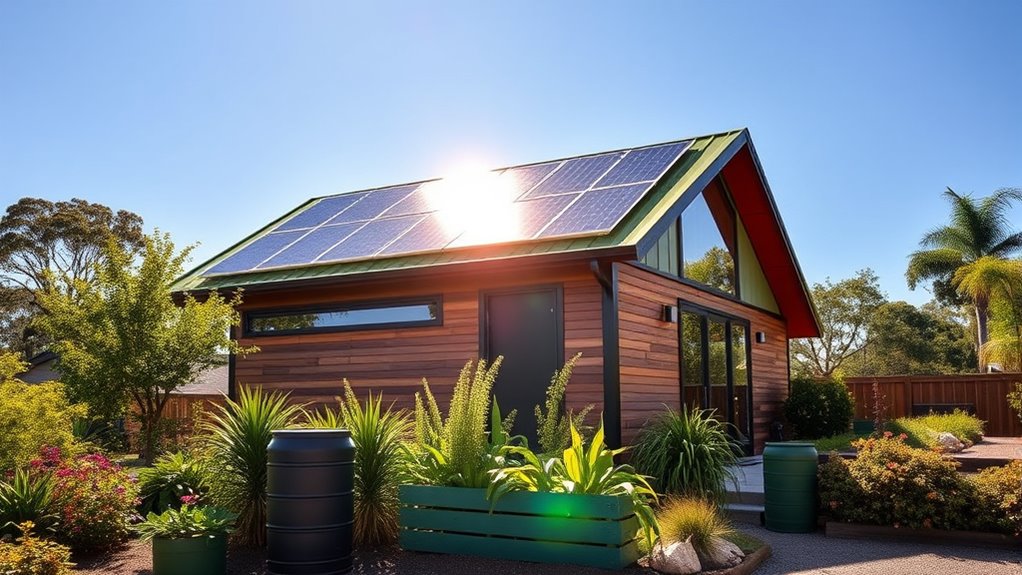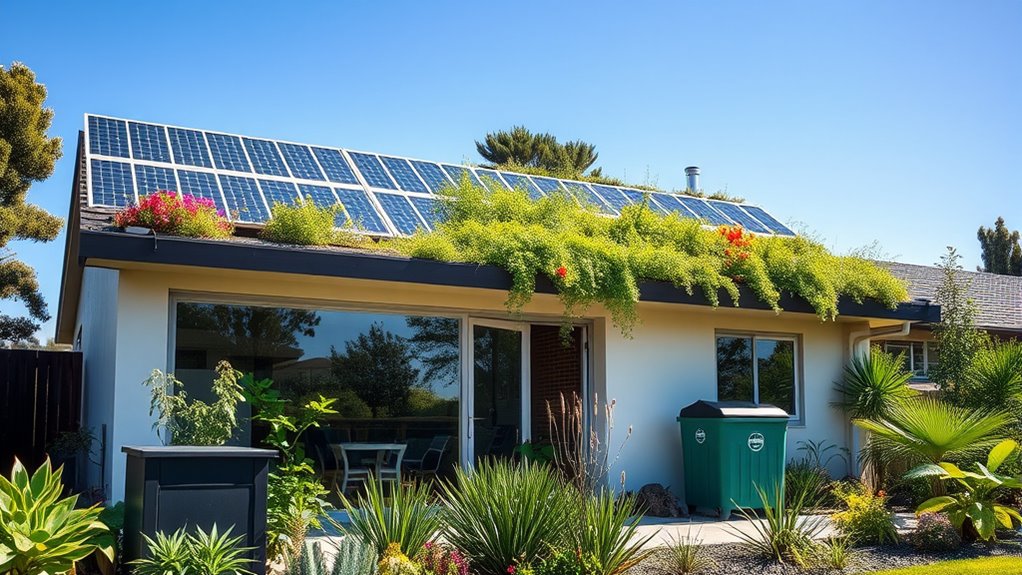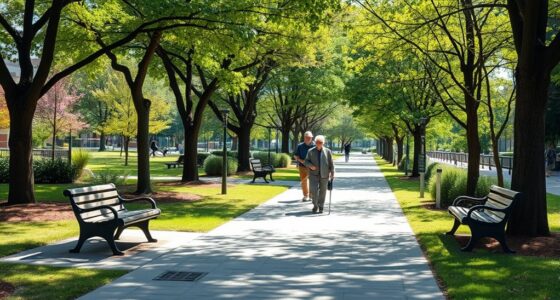Choosing sustainable design options like using renewable materials and energy-efficient appliances helps cut ongoing costs and reduces environmental harm. Incorporate features such as high-performance insulation, natural lighting, and renewable energy sources like solar panels to save money over time. Locally sourced materials also lower transportation emissions. These smart choices create healthier spaces while boosting your property’s value and sustainability. Keep exploring how combining these strategies can maximize both savings and eco-friendly benefits for your project.
Key Takeaways
- Using renewable, locally sourced materials reduces transportation emissions and minimizes environmental impact.
- Incorporating energy-efficient windows, insulation, and appliances lowers energy consumption and operational costs.
- Designing with natural lighting and ventilation decreases artificial energy use and enhances occupant comfort.
- Installing renewable energy systems like solar panels and wind turbines reduces reliance on fossil fuels.
- Prioritizing sustainable materials and thoughtful design increases property value while supporting environmental health.

Have you ever wondered how your design choices can impact the environment? When you prioritize sustainable design, you’re not just creating beautiful spaces—you’re making a difference. One of the most effective ways to do this is by selecting renewable materials. These are resources that can be replenished naturally and quickly, such as bamboo, cork, or reclaimed wood. Using renewable materials reduces reliance on finite resources and minimizes environmental degradation. Plus, they often have a lower carbon footprint compared to traditional building materials. Incorporating these into your projects shows a commitment to sustainability, which can also appeal to eco-conscious clients and users.
Beyond material choices, focusing on energy efficiency plays a *vital* role in sustainable design. When your spaces are built or renovated with energy efficiency in mind, you *greatly* cut down on energy consumption. This can involve installing high-performance windows, using insulation that minimizes heat loss, or choosing energy-efficient appliances and lighting. These decisions don’t just benefit the environment—they also save you money over time. Reduced energy bills mean lower operational costs, making your project more economical in the long run. Plus, energy-efficient designs often qualify for green building certifications, which can enhance the value and marketability of your property.
Focusing on energy efficiency cuts costs and boosts property value through sustainable design.
Making these choices isn’t complicated, but it does require a thoughtful approach. For example, selecting renewable materials that are locally sourced reduces transportation emissions and supports local economies. Meanwhile, designing with energy efficiency in mind means considering the building’s orientation, natural lighting, and ventilation to minimize artificial energy use. You can also incorporate renewable energy sources like solar panels or wind turbines into your design to further decrease reliance on fossil fuels. These strategies work together to create a space that’s both environmentally friendly and cost-effective.
Ultimately, integrating renewable materials and prioritizing energy efficiency isn’t just about ticking boxes on a sustainability checklist. It’s about creating spaces that are healthier for occupants and kinder to the planet. Every decision you make, from the materials you select to the systems you install, contributes to a larger positive impact. By doing so, you’re not only saving money through lower operating costs but also helping to reduce the carbon footprint of your projects. Sustainable design is a smart, forward-thinking approach that benefits everyone—your clients, the environment, and future generations. Incorporating sustainable practices can also motivate continuous improvement and innovation in your projects.
Frequently Asked Questions
How Do Sustainable Materials Impact Overall Project Costs?
Sustainable materials can impact your project costs in several ways. While they might have higher upfront expenses, their durability reduces maintenance and replacement costs over time. Additionally, sourcing materials through a reliable supply chain guarantees consistency and lowers delays. Overall, investing in durable, eco-friendly materials can balance initial costs and long-term savings, making your project more cost-effective and environmentally responsible.
Are Green Building Certifications Necessary for Cost Savings?
Green certification isn’t always necessary for cost benefits, but it can add value by demonstrating your commitment to sustainability. Achieving a green certification like LEED can improve energy efficiency and reduce operational costs over time. While initial expenses might be higher, the long-term savings often outweigh them, making the certification a smart investment. Ultimately, it helps you balance upfront costs with ongoing savings and environmental benefits.
What Are the Long-Term Maintenance Costs of Sustainable Designs?
Your sustainable design choices, like eco-friendly landscaping and solar energy integration, often seem like tiny investments, but they can save you a fortune over time. Long-term maintenance costs are generally lower because eco-friendly materials and systems require less frequent repairs and upgrades. Plus, solar panels and smart landscaping reduce energy bills and water usage, making your property more efficient and eco-conscious—truly a win for your wallet and the planet!
How Can I Measure the Environmental Impact of Design Choices?
To measure the environmental impact of your design choices, you should start with a carbon footprint assessment, which tracks greenhouse gas emissions. Conducting a life cycle analysis helps you evaluate the environmental effects from material extraction to disposal. By comparing these metrics, you can identify areas to improve, ensuring your design choices reduce overall environmental impact and support sustainability goals effectively.
What Financing Options Are Available for Sustainable Building Projects?
You might think financing sustainable building projects is complicated, but options like solar incentives and green loans make it easier. You can access grants or tax credits for solar incentives, reducing upfront costs. Green loans often offer favorable terms for eco-friendly projects, helping you invest in sustainable design without straining your budget. These financing options make it more feasible to prioritize environmentally responsible choices while managing your project’s expenses effectively.
Conclusion
Think of your home as a garden you tend with care. Every sustainable choice you make is like planting a seed that grows into a thriving tree—saving you money and helping the planet flourish. Your decisions ripple outward, shaping a future where nature and innovation coexist. By choosing wisely today, you’re nurturing a legacy of beauty and resilience. Embrace these choices, and watch your world blossom into a sanctuary of harmony and hope.









